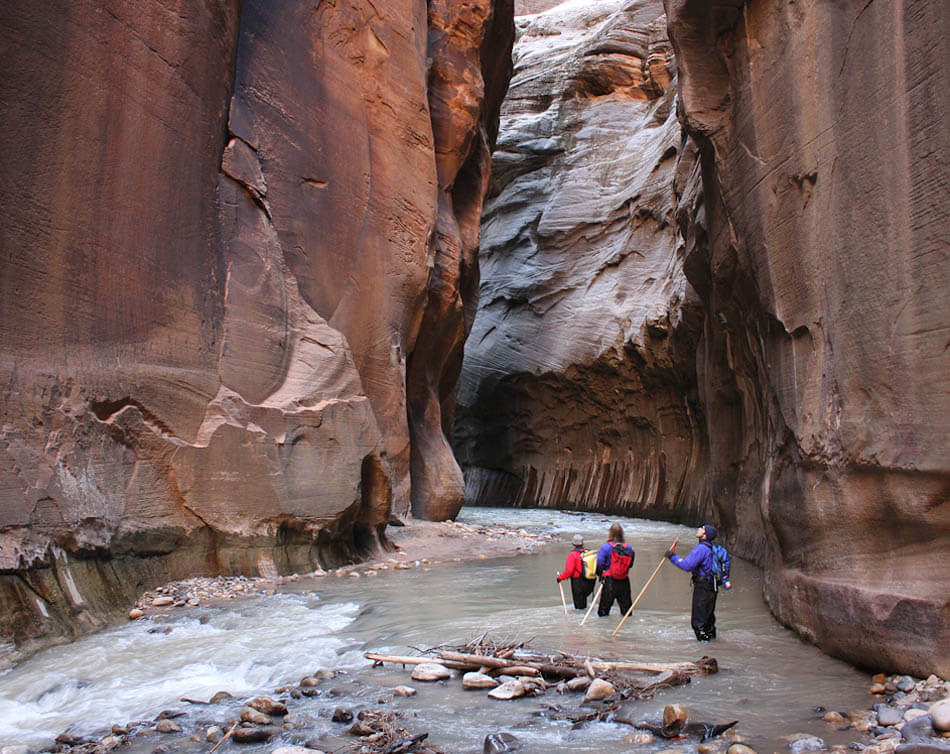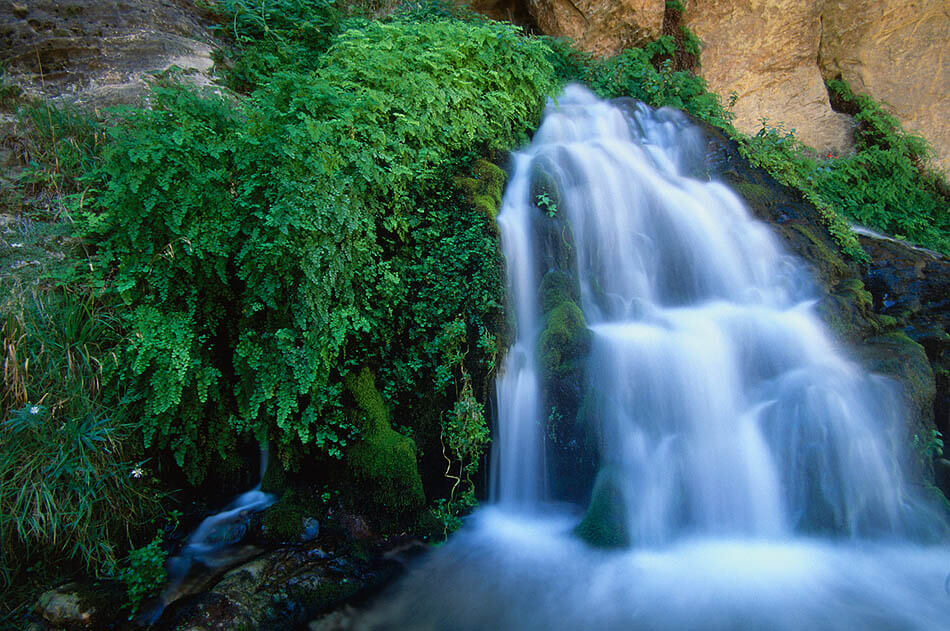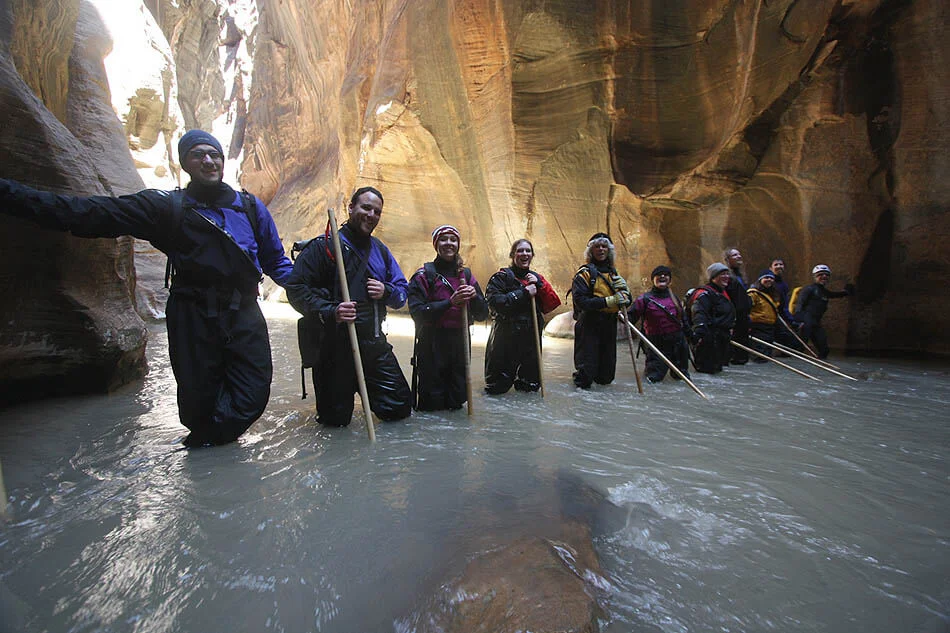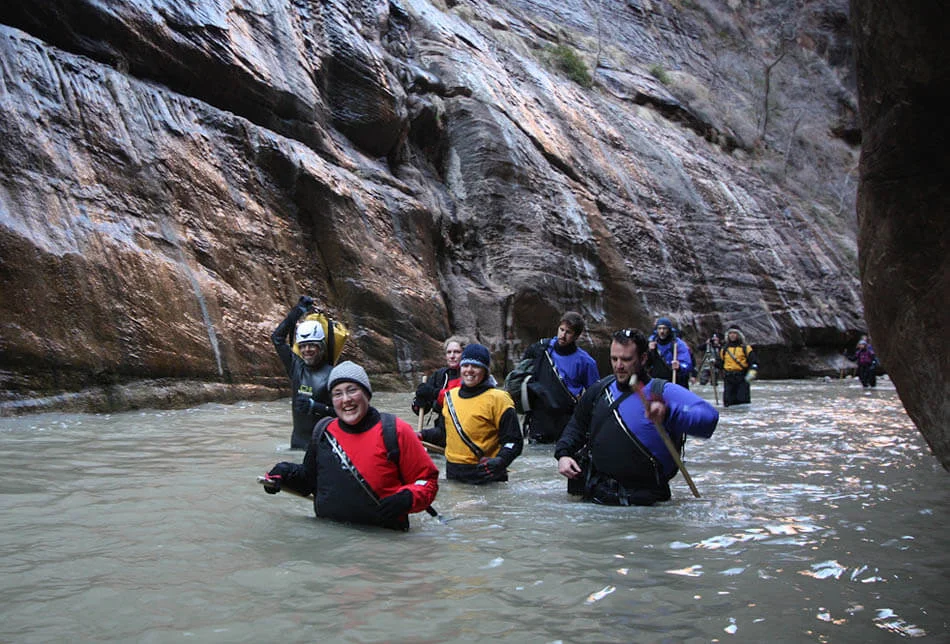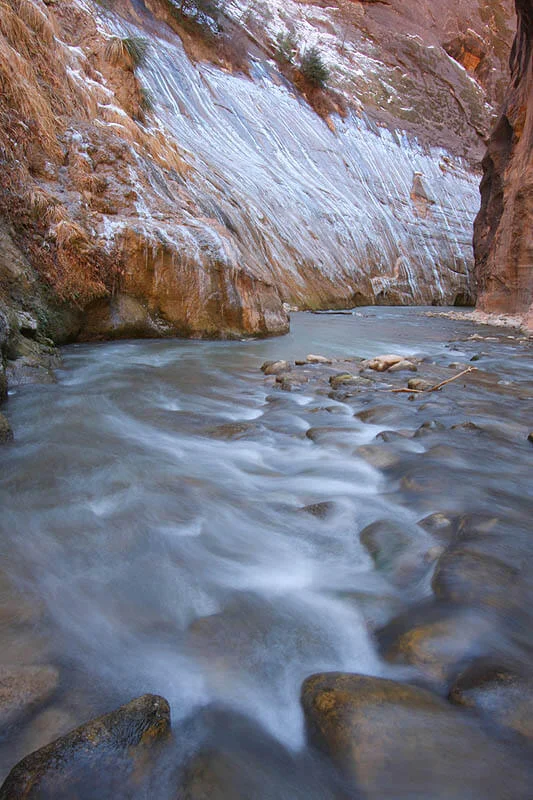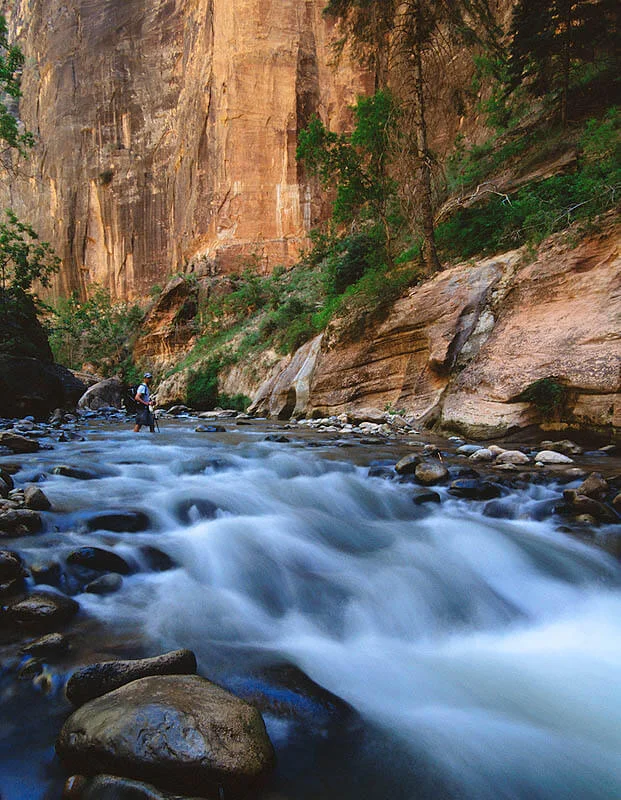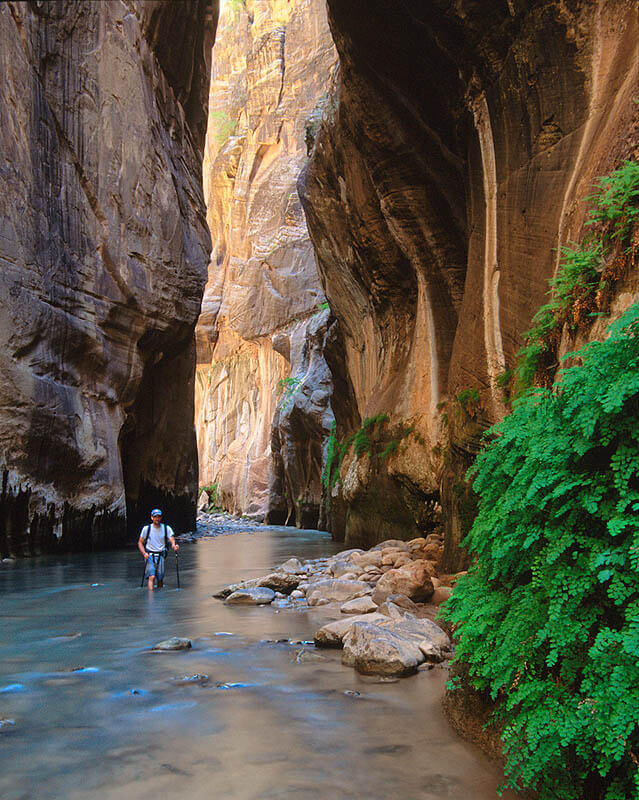The Classic.
The walk UP the Zion Narrows from the Temple of Sinawava is a wonderful hike, perhaps the third-best "trail" in the Park. Even with a side-trip up Orderville Canyon (highly recommended) the logistics are simple, and the trip can be a couple-of-hours thing, a half-day hike, or a full-day adventure. Accessible to anyone with solid walking abilities and a sense of adventure and fun, the Narrows has probably seen more visitors than any canyon on Earth. Canyoneering for everyone!
The unique aspect of the Narrows hike is you must get wet to see the goods, and this watery complication creates most of the highlights and complications of the hike. As in all canyoneering, water can be friend or foe; during summer, crowds throng to the Narrows to splash around and escape the heat, while during colder months, one must take serious precations to hike the Narrows comfortably. Thankfully, the hike is always worth the effort. Even during winter, its most diffiuclt season, the Narrows can be an extraordinary place, with beautiful ice sculptures forming at springs, seeps, and intersecting canyons.
hike Profile
Logistics

RATINGS
Non-technical, mildly to moderately strenuous hike

DISTANCE/TIME REQUIRED
Varies. Most hikers walk 4-10 miles.
4 to 9 hours

SEASON
Often can be done year round. May-November usually have best temperatures and river conditions. River flow must be below 150 CFS.

ELEVATION GAIN
200 feet (60 m)

SHADE
Regularly available. Most of the hike is in the shade of the canyon walls.

PERMIT
NO
Equipment

ESSENTIALS
Good river hiking footwear & a way to keep your food & electronics dry.
Wetsuits or drysuit recommended Nov-April

DRINKING WATER
Available to purify.

FLASH FLOOD RISK
High - Pay close attention to weather report and current conditions.

ACCESS
Starts and finishes at the Temple of Sinawava. Park shuttle required March-October.
Seasonal Adjustments
HIGH SUMMER: MAY 15 - SEPTEMBER 15
High summer is the best time to through-hike the Narrows. Zion National Park can be downright sweltering in the summer months, so escaping into the deep, twisty and cool river gorge makes for a delightful escape from the heat. Water levels are generally low, and only a spot or two of deep wading or swimming is required. First of June, the water is cold, but as the summer progresses the water becomes warmer and warmer.
High summer is, however, thunderstorm season in the desert southwest. The Monsoon pattern can set up anytime during high summer, making the Zion Narrows hike dodgy at best. This is a good time to explore the Narrows from the bottom up, starting early in the morning, and keeping a careful eye on the sky. The weather forecast and flashflood warning level is posted early each morning at the Visitor Center – be sure to check it before heading out.
Even without the Monsoon, the Narrows should be hiked with a keen eye on the sky to the north. Thunderstorms occur largely in the late afternoon, so get up early and put those miles in before mid-afternoon, so you will be in a safe place during those critical hours 3:00 PM to 10:00 PM. The North Fork watershed comprises 400 square miles of terrain mostly north of The Narrows. Hard rain in any part of this watershed can cause flooding, sometimes with several hours of delay.
The top half of the Zion Narrows hike can be hot and sunny, especially in July and August. Get an early start, be prepared for heat, and bring sunscreen.
AUTUMN: SEPTEMBER 15 - NOVEMBER 1
Fall is lovely in Zion, and The Narrows is at its most spectacular. The slanting light can be amazing, and the colorful leaves complement the colorful walls. Fabulous.
The water level tends to be very low, and hiking in the river is at its easiest. Air and water temperatures are lower and care must be taken to be properly attired to avoid a chill. The days are shorter, early starts more difficult.
WINTER: NOVEMBER 1 - MARCH 15
Winter is a great time to visit the Zion Narrows, though specialized equipment is required to stay warm. With few visitors in the lower reaches, hiking up from the bottom has a wilderness feel to it lost in the summer crowds. A dry suit and thick neoprene socks can make hiking a very reasonable proposition – equipment can be rented in Springdale.
A through-hike in the winter is difficult. The road to Chamberlain ranch is often closed in the winter, even to 4WD vehicles. The water is frigid, requiring dry suits and thick neoprene socks from the start. If the sun is out and snow is melting in the high country, the river level can rise rapidly. Ice falling off the walls can also be a hazard.
SPRING: MARCH 15 - MAY 15
Spring is a great time to visit Zion, but not The Narrows. The Virgin River is high and cold, fed by melting snow in the headwaters to the north. River levels are unpredictable – a lot depends on the upper level snowpack, and when and where the sun comes out. March and April are also the rainiest months in Utah. Toward the end of May, Zion changes over to summer conditions. Though the water is chilly, if the snow has melted out, the river gets down to a reasonable level and the hike is great.
Getting there
Take the shuttle (March-October) or drive your car (November-February) to the Temple of Sinawava. Complete any unfinished business in the bathroom, then head up the paved Riverside Walk trail, built in 1925. The walk passes through a wonderful riparian habitat, with weeping walls, hanging gardens, and wetland habitat along the way. After one mile, the trail ends at a lovely stone veranda. From there, the path is up the river. Stow any sensitive items (e.g. cameras, lunch) in waterproof protection, and plunge in. Take care with those first few steps, as getting used walking on the river cobbles can take a few minutes.
The Hike
Wade on in and go to it. The river is initially shallow, with no wades above waist-deep for an hour or so. Work your way up the river. About 15 minutes upcanyon, Mystery Falls slides 120 feet (40 m) down a slab on the right. Makes for a good "shampoo commercial" photo.
The river winds its way through the stone, with walls soaring 800 feet into the air. Please walk in the river or on established trails next to the water. There are many unnecessary and sadly destructive hiker-made trails up hills and over dales; don't use these.
A bit further upstream, the river turns sharply to the left, the start of a gooseneck. In the next four-tenths of a mile, the river will swing back to the right and end up a mere 400 feet from the start. The gooseneck (and the meandering course of the entrenched river) indicates that the river established a windy course on a relatively flat valley before the uplift came along and lifted the land, the river working hard to stay where it was.
Not far past the gooseneck, the river takes a big sweeping turn to the right, forming a deep, dark alcove on the left. The seeping walls and rushing river combine with outstanding light at certain times of the year (and day) to produce one of the most-photographed places on the Zion Narrows hike. The light and conditions challenge the photographer to capture the essence of The Narrows, but it is really fun to try.
Orderville Junction
Not far past the Alcove, Orderville Canyon enters The Narrows on the right as a 20-foot wide, twisty slot with high walls and a small stream flowing in the bottom. The intrepid hiker faces a choice: continue up The Narrows, or visit Orderville... or both?
If you can only do one, hike up Orderville to experience a wider variety of canyon scenery. But first, let's finish hiking up the Narrows.
The Narrows above Orderville: The Wall Street Corridor
Below Orderville, the Narrows is a windy river with frequent pocket forests on the sides, bits of sunlight, lots of people and short sections of tall, intense narrows. Above Orderville, the walls soar upward, the crowds thin out and the sun hides behind the walls. This is the Wall Street Corridor. The 2 miles (3.2 km) to Big Springs is the most impressive and continuous section of The Narrows. In winter, numerous seeps and small waterfalls are highlighted by the ice sculptures they form. A couple spots may require deep wading or short swims.
Big Springs is easily identified. Beautiful clear water gushes from the canyon wall, flowing 20 feet through lush greenery before dropping into the river. Watch out for poison ivy in the area.
The canyon changes nature at Big Springs, opening up and regaining pocket forests on each side, and becoming rougher as giant boulders often block easy hiking up-canyon. The Park prohibits hikers from hiking up-canyon past Big Springs, so this is your turn-around point.
Orderville Canyon from Orderville Junction
Orderville is cool, Orderville is fun! While the Zion Narrows soar, somber and awe-inspiring, Orderville is more playful. Hiking up the Narrows, you are, well, hiking. Charging up Orderville involves swimming, wading, scrambling, splashing through water and climbing over obstacles.
The first part of Orderville is a narrow, soaring slot almost like an alley between two buildings. Look up to see the marvelous light bouncing off the walls. A small stream runs in the bottom, often carrying silt and sometimes a malodorous scent. Rain washes silt, pine needles and leaves into the canyon higher up; the leaves and pine needles rot, producing aromatic matter carried into the stream. The silt can make the canyon slippery and swimming the pools can be a down-and-dirty proposition.
Ten minutes up Orderville, the canyon's character changes again as the canyon opens up briefly. A multi-colored wall on the right can be seen rising 1000 feet in several tiers. Soon afterward, a deep pool often requires a short swim or deep wade. Cross the pool, and clamber up the logs and rocks on the other side.
Next up is Veiled Falls, where a short waterfall drops into a slot. Moki steps on the right allow passage around the waterfall.
*** This is a good place for Tom's Safety Talk on Jumping. It is amazing how many people each year jump into a shallow pool when they cannot see the bottom, and are surprised to hear their bones break. Jumping is fun, but breaking bones is not. There are very few places in Zion where jumping is safe, and none of them are in Orderville. The murky water is very successful at hiding the bottom. Don't jump! ***
Above Veiled Falls, about 45 minutes from the Narrows, find the next fun spot, Corkscrew Falls. This is also the first spot that can be a challenge to get up. As you continue up-canyon past this and other obstacles, remember it is harder to climb down than it is to climb up. Don't climb up obstacles you cannot climb down.
There are many more fun spots. The next landmark is The Guillotine, where a very large block hangs wedged between the canyon walls. About 45 minutes above the Guillotine, the canyon becomes dry and the scenery less impressive.
Returning to Civilization
Return the way you came. Hiking back down Orderville and the Narrows takes less time than hiking up. Hiking the river in the dark is extremely challenging and extremely slow, so plan to complete your hike during daylight hours.
Author's Experience
The Narrows hike was my very first Zion canyon, in October 1986, bottom up. Without anything warm on my feet, however, I did not get very far. After moving to Utah, a top-down Narrows run with fellow BDer Stan Brown was my new intro to Zion, circa 1996. Since then, I have spent a lot of time in the Narrows, mostly while exiting technical canyons and mostly at night, but have hiked it as a backpack trip twice, and as a one-day run-through maybe only one more time. It is still a favorite place to wander up on a hot summer day.
***The Narrows is a beautiful and popular hike, but hikers must be aware of floods. The river floods regularly; here are some stories of hikers caught in flash floods.***
From Zion: Canyoneering by Tom Jones:
September 17, 1961 – Flood in the Zion Narrows
Thunderstorm-induced flooding produced the largest flood recorded in 25 years. Unfortunately, it found 26 members of the Scotowa Expedition hiking the North Fork Narrows. Twenty-one eventually walked out, but five were swept to their deaths.
September 5, 1965 – Flash Flood in the Zion Narrows
Labor Day weekend, 1965, found parties from Los Angeles, Provo and Salt Lake City enjoying overnight trips in The Narrows. Massive rains early Sunday morning flooded the canyon. Over the next two days, all 42 hikers eventually made it to safety, but only after many anxious moments, making their way down the flooded river.
June 3, 1973 – Search and Rescue in The Narrows
After 32 hours, a three-man scuba rescue team located stranded hikers Bob and Harry Pattison in the depths of a very flooded Zion Narrows. Stranded for 5 days, the Pattison's had found high ground and stayed put, though by the time rescue arrived they were cold and hungry. Evacuation down the river was effected with the assistance of a rubber raft and ropes.
1992-437 - Zion (Utah) Rescue – The Zion Narrows
Just after 1:00 p.m. on August 11th, Michael N. of El Toro, California, reported that his wife, 47, and his son and two daughters, all in their mid 20s, were in trouble in Narrows and needed assistance. The family planned a one night campout in the Narrows over August 9th and 10th; they'd hiked about ten hours the first day, but had not quite reached the park boundary, four miles from the trailhead. They camped, then continued downstream on Monday, the 10th, but covered less than four miles. During the hike, N. and his wife had become separated from the rest of the family because of flash floods. N's wife, who weighed 230 pounds and was taking medication for her heart, began having cardiac problems and injured her leg. N. hiked out through the rest of the Narrows on Tuesday without seeing his children, and reported the situation to rangers.
While arrangements were being made to secure a helicopter, the son hiked out of the Narrows to report that his two sisters had returned to help their mother. In doing so, one of his sisters had fallen and apparently broken her tailbone, so was now unable to hike out on her own. FIREPRO personnel Eric Lutz and Koby Barnhurst were dispatched to the trailhead to hike downstream to the three women, and reached them despite considerable difficulty with flash floods. They spent the night with the N.'s, providing food and water and assessing their medical situation. At the time of the report, plans were to get the party to the top of Narrows canyon so that they could be airlifted from the area if necessary.
2000-647 - Zion NP (UT) - Rescue – The Narrows
On October 11th, an air and ground search was begun for a four-person party that was overdue from an overnight trip through the Narrows. Rain caused the Virgin River to increase in flow from 50 to 250 cubic feet per second. A search helicopter located the party that afternoon in the Narrows section of the river's canyon near the exit of Mystery Canyon. Ground searchers contacted the party and escorted them out of the canyon. The foursome stayed on an isolated area of high ground within the canyon until the river flow dropped to a level that they could manage.
2002-164 - Zion NP (UT) - Rescue – Orderville
Rangers evacuated an injured hiker from the Narrows on May 7th. At approximately 3:55 p.m., the park dispatch office received notification of an injured hiker in Orderville Canyon. The park SAR team found Chris E., from Spokane, Washington, with an injured ankle and unable to walk. They splinted his ankle, placed him on a litter, then put him in an inflatable rescue raft for evacuation from the Narrows. The rescue effort was completed at 9:45 p.m.
E. had been day hiking in the Narrows and was exploring the lower reaches of Orderville Canyon when he jumped down and injured his ankle. He was not wearing sturdy footwear with good ankle support, as is recommended for hikers in the Narrows. The inflatable rescue raft was designed and built especially for Zion National Park for rescues such as this one. This incident marked the first use for the new raft; members of the SAR team were very pleased with its performance.
Trip Reports
Maps
Click for higher resolution



